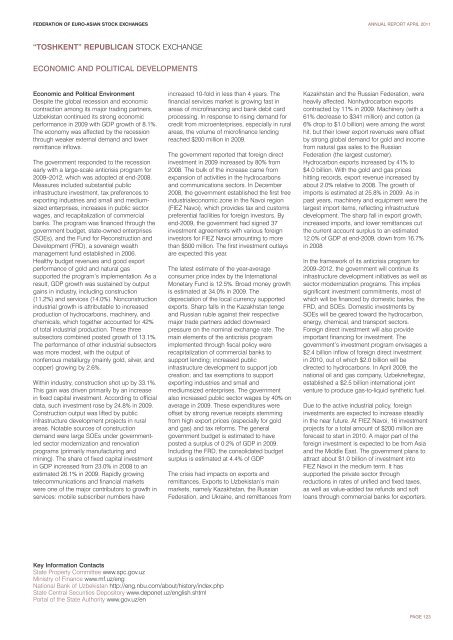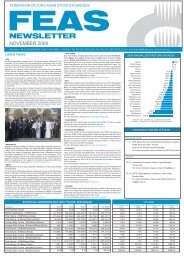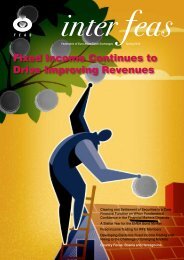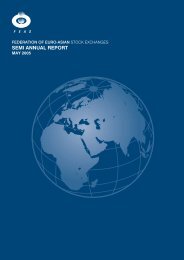Download - FEAS
Download - FEAS
Download - FEAS
Create successful ePaper yourself
Turn your PDF publications into a flip-book with our unique Google optimized e-Paper software.
FEDERATION OF EURO-ASIAN STOCK EXCHANGES ANNUAL REPORT APRIL 2011<br />
“TOSHKENT” REPUBLICAN STOCK EXCHANGE<br />
ECONOMIC AND POLITICAL DEVELOPMENTS<br />
Economic and Political Environment<br />
Despite the global recession and economic<br />
contraction among its major trading partners,<br />
Uzbekistan continued its strong economic<br />
performance in 2009 with GDP growth of 8.1%.<br />
The economy was affected by the recession<br />
through weaker external demand and lower<br />
remittance inflows.<br />
The government responded to the recession<br />
early with a large-scale anticrisis program for<br />
2009–2012, which was adopted at end-2008.<br />
Measures included substantial public<br />
infrastructure investment, tax preferences to<br />
exporting industries and small and mediumsized<br />
enterprises, increases in public sector<br />
wages, and recapitalization of commercial<br />
banks. The program was financed through the<br />
government budget, state-owned enterprises<br />
(SOEs), and the Fund for Reconstruction and<br />
Development (FRD), a sovereign wealth<br />
management fund established in 2006.<br />
Healthy budget revenues and good export<br />
performance of gold and natural gas<br />
supported the program’s implementation. As a<br />
result, GDP growth was sustained by output<br />
gains in industry, including construction<br />
(11.2%) and services (14.0%). Nonconstruction<br />
industrial growth is attributable to increased<br />
production of hydrocarbons, machinery, and<br />
chemicals, which together accounted for 42%<br />
of total industrial production. These three<br />
subsectors combined posted growth of 13.1%.<br />
The performance of other industrial subsectors<br />
was more modest, with the output of<br />
nonferrous metallurgy (mainly gold, silver, and<br />
copper) growing by 2.6%.<br />
Within industry, construction shot up by 33.1%.<br />
This gain was driven primarily by an increase<br />
in fixed capital investment. According to official<br />
data, such investment rose by 24.8% in 2009.<br />
Construction output was lifted by public<br />
infrastructure development projects in rural<br />
areas. Notable sources of construction<br />
demand were large SOEs under governmentled<br />
sector modernization and renovation<br />
programs (primarily manufacturing and<br />
mining). The share of fixed capital investment<br />
in GDP increased from 23.0% in 2008 to an<br />
estimated 26.1% in 2009. Rapidly growing<br />
telecommunications and financial markets<br />
were one of the major contributors to growth in<br />
services: mobile subscriber numbers have<br />
increased 10-fold in less than 4 years. The<br />
financial services market is growing fast in<br />
areas of microfinancing and bank debit card<br />
processing. In response to rising demand for<br />
credit from microenterprises, especially in rural<br />
areas, the volume of microfinance lending<br />
reached $200 million in 2009.<br />
The government reported that foreign direct<br />
investment in 2009 increased by 80% from<br />
2008. The bulk of the increase came from<br />
expansion of activities in the hydrocarbons<br />
and communications sectors. In December<br />
2008, the government established the first free<br />
industrialeconomic zone in the Navoi region<br />
(FIEZ Navoi), which provides tax and customs<br />
preferential facilities for foreign investors. By<br />
end-2009, the government had signed 37<br />
investment agreements with various foreign<br />
investors for FIEZ Navoi amounting to more<br />
than $500 million. The first investment outlays<br />
are expected this year.<br />
The latest estimate of the year-average<br />
consumer price index by the International<br />
Monetary Fund is 12.5%. Broad money growth<br />
is estimated at 34.0% in 2009. The<br />
depreciation of the local currency supported<br />
exports. Sharp falls in the Kazakhstan tenge<br />
and Russian ruble against their respective<br />
major trade partners added downward<br />
pressure on the nominal exchange rate. The<br />
main elements of the anticrisis program<br />
implemented through fiscal policy were<br />
recapitalization of commercial banks to<br />
support lending; increased public<br />
infrastructure development to support job<br />
creation; and tax exemptions to support<br />
exporting industries and small and<br />
mediumsized enterprises. The government<br />
also increased public sector wages by 40% on<br />
average in 2009. These expenditures were<br />
offset by strong revenue receipts stemming<br />
from high export prices (especially for gold<br />
and gas) and tax reforms. The general<br />
government budget is estimated to have<br />
posted a surplus of 0.2% of GDP in 2009.<br />
Including the FRD, the consolidated budget<br />
surplus is estimated at 4.4% of GDP<br />
The crisis had impacts on exports and<br />
remittances. Exports to Uzbekistan’s main<br />
markets, namely Kazakhstan, the Russian<br />
Federation, and Ukraine, and remittances from<br />
Kazakhstan and the Russian Federation, were<br />
heavily affected. Nonhydrocarbon exports<br />
contracted by 11% in 2009. Machinery (with a<br />
61% decrease to $341 million) and cotton (a<br />
6% drop to $1.0 billion) were among the worst<br />
hit, but their lower export revenues were offset<br />
by strong global demand for gold and income<br />
from natural gas sales to the Russian<br />
Federation (the largest customer).<br />
Hydrocarbon exports increased by 41% to<br />
$4.0 billion. With the gold and gas prices<br />
hitting records, export revenue increased by<br />
about 2.0% relative to 2008. The growth of<br />
imports is estimated at 25.8% in 2009. As in<br />
past years, machinery and equipment were the<br />
largest import items, reflecting infrastructure<br />
development. The sharp fall in export growth,<br />
increased imports, and lower remittances cut<br />
the current account surplus to an estimated<br />
12.0% of GDP at end-2009, down from 16.7%<br />
in 2008<br />
In the framework of its anticrisis program for<br />
2009–2012, the government will continue its<br />
infrastructure development initiatives as well as<br />
sector modernization programs. This implies<br />
significant investment commitments, most of<br />
which will be financed by domestic banks, the<br />
FRD, and SOEs. Domestic investments by<br />
SOEs will be geared toward the hydrocarbon,<br />
energy, chemical, and transport sectors.<br />
Foreign direct investment will also provide<br />
important financing for investment. The<br />
government’s investment program envisages a<br />
$2.4 billion inflow of foreign direct investment<br />
in 2010, out of which $2.0 billion will be<br />
directed to hydrocarbons. In April 2009, the<br />
national oil and gas company, Uzbekneftegaz,<br />
established a $2.5 billion international joint<br />
venture to produce gas-to-liquid synthetic fuel.<br />
Due to the active industrial policy, foreign<br />
investments are expected to increase steadily<br />
in the near future. At FIEZ Navoi, 16 investment<br />
projects for a total amount of $200 million are<br />
forecast to start in 2010. A major part of the<br />
foreign investment is expected to be from Asia<br />
and the Middle East. The government plans to<br />
attract about $1.0 billion of investment into<br />
FIEZ Navoi in the medium term. It has<br />
supported the private sector through<br />
reductions in rates of unified and fixed taxes,<br />
as well as value-added tax refunds and soft<br />
loans through commercial banks for exporters.<br />
Key Information Contacts<br />
State Property Committee www.spc.gov.uz<br />
Ministry of Finance www.mf.uz/eng<br />
National Bank of Uzbekistan http://eng.nbu.com/about/history/index.php<br />
State Central Securities Depository www.deponet.uz/english.shtml<br />
Portal of the State Authority www.gov.uz/en<br />
PAGE 123
















